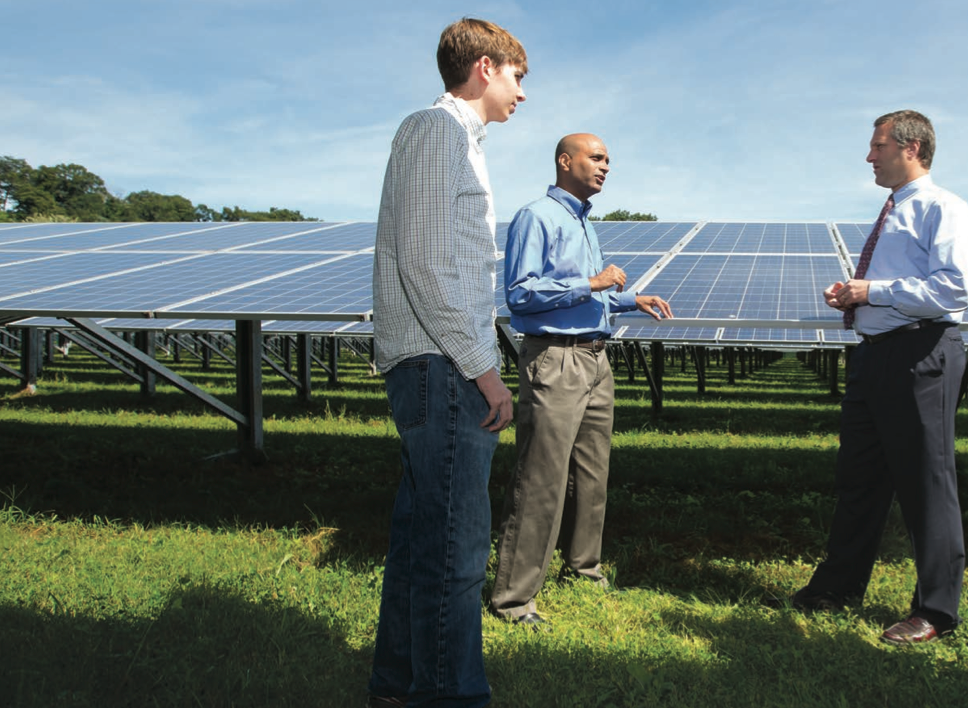
From ResearchNext the Research Digest of UMass Amherst
UMass Amherst computer scientist Prashant Shenoy and electrical and computer engineer David Irwin are leading a team of researchers focused on analyzing smart meters and other tools that could transform the way energy is utilized, monitored, and controlled in America’s buildings, which currently comprise 75% of the national electric bill. Along with partner Holyoke Gas and Electric (HG&E), Shenoy and his team are analyzing data from 18,000 smart meters in the city of Holyoke. The analysis will be used by projects that include design of smarter thermostats, a web-based solar predictor, and an electrical reserve battery.
The average home or office is but one tiny unit in our western Massachusetts and are continuing to expand  greater energy grid, but given that America’s buildings rake up 75 percent of the national electric bill, energy efficiency needs to begin there. UMass Amherst computer scientist Prashant Shenoy and electrical and computer engineer David Irwin are leading a team of researchers focused on analyzing smart meters and other tools that could transform the way energy is utilized, monitored, and controlled in U.S. buildings.
The National Science Foundation funded Shenoy’s foundational smart-grid research, and now he and his team are moving into the deployment phase with several new technologies intended to help residents and utility companies achieve their energy goals. Along with partner Holyoke Gas and Electric (HG&E), Shenoy and his team are analyzing 18,000 smart meters deployed in their efforts. Whereas previous meters recorded data once a month, these record electricity data constantly and feed it wirelessly to the electric utility. Because this information yields patterns—peak usage times, appliance usage, and more—it is invaluable in making buildings more efficient.
“Information is a big part of the puzzle. To make a building smarter, greener, more energy-efficient, you first need to understand its energy consumption,” says Shenoy.
In the next phase of the project that is funded by the Massachusetts Department of Energy Resources (DOER), Shenoy and the team will use a computational cluster at the Massachusetts Green High Performance Computing Center to interpret and analyze data collected by the smart meters in Holyoke. The data will feed several subprojects already underway, which include an automated thermostat, a web-based solar predictor, and an electrical reserve battery. The automated thermostat device uses building-specific data to make customized usage recommendations and implement such simple yet effective changes as automatically adjusting the thermostat when no one is home.
“Once we started collecting the data, it seemed like we didn’t have to stop there. We could do a lot more with it,” Shenoy says.
The reserve battery that Shenoy and the team are working on will help utility companies manage cold spikes and heat waves — times that often overload transformers and cause blackouts, breakdowns, and expensive repairs. The battery will sense when energy demand is low and draw off excess electricity in the grid to build a reserve. In turn, when a transformer is overburdened, the battery’s electricity will automatically release into the grid to ease the strain. Similarly, the solar energy predictor improves on existing technology to facilitate better energy management and help the grid work more efficiently. The web-based system will be synchronized with the National Weather Service and alert residents and utility companies with solar panels of an upcoming good-weather day that is likely to call for maximum energy generation. This enables users to better plan laundry loads and other high-energy activities so that they can make use of the energy locally rather than feeding it to the grid, where it is often wasted. With a 5-megawatt solar facility at its disposal— one of the largest in New England—HG&E is eager to put the planning tool into practice.
“It’s important for utilities to understand how to most efficiently utilize new technology. This is a mutually beneficial relationship,” says HG&E Project Engineer Sarah LaRose of the utility’s partnership with Shenoy and his team. Shenoy believes that his data-monitoring skills will have a positive impact in the effort for a more sustainable society. He attributes the project’s success to the regional cross-disciplinary collaboration that is putting foundational science into practice.
“I think the stars are aligned in some sense for us. We have a municipal utility willing to try this out, we have the Massachusetts Green High Performance Computing Center able to provide the resources to do the big-data research, and we’ve already developed the technology and it’s ready to go,” says Shenoy.
Story my Amanda Drane UMass '12